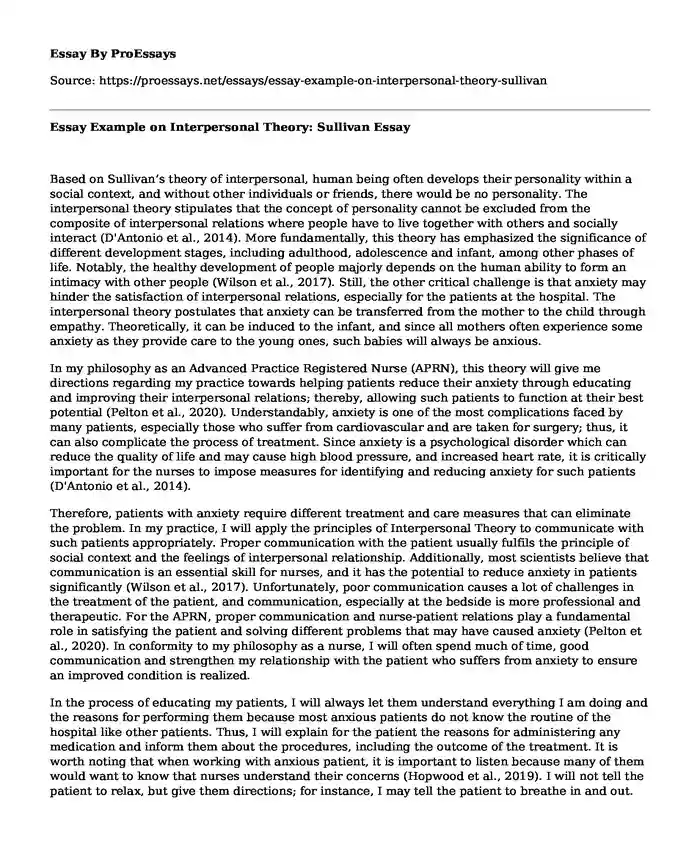Based on Sullivan’s theory of interpersonal, human being often develops their personality within a social context, and without other individuals or friends, there would be no personality. The interpersonal theory stipulates that the concept of personality cannot be excluded from the composite of interpersonal relations where people have to live together with others and socially interact (D'Antonio et al., 2014). More fundamentally, this theory has emphasized the significance of different development stages, including adulthood, adolescence and infant, among other phases of life. Notably, the healthy development of people majorly depends on the human ability to form an intimacy with other people (Wilson et al., 2017). Still, the other critical challenge is that anxiety may hinder the satisfaction of interpersonal relations, especially for the patients at the hospital. The interpersonal theory postulates that anxiety can be transferred from the mother to the child through empathy. Theoretically, it can be induced to the infant, and since all mothers often experience some anxiety as they provide care to the young ones, such babies will always be anxious.
In my philosophy as an Advanced Practice Registered Nurse (APRN), this theory will give me directions regarding my practice towards helping patients reduce their anxiety through educating and improving their interpersonal relations; thereby, allowing such patients to function at their best potential (Pelton et al., 2020). Understandably, anxiety is one of the most complications faced by many patients, especially those who suffer from cardiovascular and are taken for surgery; thus, it can also complicate the process of treatment. Since anxiety is a psychological disorder which can reduce the quality of life and may cause high blood pressure, and increased heart rate, it is critically important for the nurses to impose measures for identifying and reducing anxiety for such patients (D'Antonio et al., 2014).
Therefore, patients with anxiety require different treatment and care measures that can eliminate the problem. In my practice, I will apply the principles of Interpersonal Theory to communicate with such patients appropriately. Proper communication with the patient usually fulfils the principle of social context and the feelings of interpersonal relationship. Additionally, most scientists believe that communication is an essential skill for nurses, and it has the potential to reduce anxiety in patients significantly (Wilson et al., 2017). Unfortunately, poor communication causes a lot of challenges in the treatment of the patient, and communication, especially at the bedside is more professional and therapeutic. For the APRN, proper communication and nurse-patient relations play a fundamental role in satisfying the patient and solving different problems that may have caused anxiety (Pelton et al., 2020). In conformity to my philosophy as a nurse, I will often spend much of time, good communication and strengthen my relationship with the patient who suffers from anxiety to ensure an improved condition is realized.
In the process of educating my patients, I will always let them understand everything I am doing and the reasons for performing them because most anxious patients do not know the routine of the hospital like other patients. Thus, I will explain for the patient the reasons for administering any medication and inform them about the procedures, including the outcome of the treatment. It is worth noting that when working with anxious patient, it is important to listen because many of them would want to know that nurses understand their concerns (Hopwood et al., 2019). I will not tell the patient to relax, but give them directions; for instance, I may tell the patient to breathe in and out. Notably, regular communication and closeness with the anxious patient usually reduce stress and have a feeling of living together with other people; hence, decreases anxiety.
References
D'Antonio, P., Beeber, L., Sills, G., & Naegle, M. (2014). The future in the past: H ildegard P eplau and interpersonal relations in nursing. Nursing Inquiry, 21(4), 311-317.
Hopwood, C. J., Pincus, A. L., & Wright, A. G. (2019). The interpersonal situation: Integrating personality assessment, case formulation, and intervention. Using Basic Personality Research to Inform Personality Pathology, 94-121.
Pelton, M. K., Crawford, H., Robertson, A. E., Rodgers, J., Baron-Cohen, S., & Cassidy, S. (2020). Understanding suicide risk in autistic adults: Comparing the Interpersonal Theory of Suicide in autistic and non-autistic samples. Journal of Autism and Developmental Disorders, 1-18.
Wilson, K. G., Heenan, A., Kowal, J., Henderson, P. R., McWilliams, L. A., & Castillo, D. (2017). Testing the interpersonal theory of suicide in chronic pain. The Clinical Journal of Pain, 33(8), 699-706.
Cite this page
Essay Example on Interpersonal Theory: Sullivan. (2023, Dec 13). Retrieved from https://proessays.net/essays/essay-example-on-interpersonal-theory-sullivan
If you are the original author of this essay and no longer wish to have it published on the ProEssays website, please click below to request its removal:
- Translation Analysis of "A Young Man Loves a Maiden" by Heinrich Heine
- Interdisciplinary Collaboration to Select a Clinical Measure
- Pomona Valley Hospital: Childbirth Prep Events & Classes - Essay Sample
- Autobiography Essay Example: My Future Plans
- American Youth Incarceration: Race Disparities in Justice System - Essay Sample
- Teaching Early Children: My Personal Philosophy - Essay Sample
- Essay Example on Testicular Pain: Causes & Symptoms







